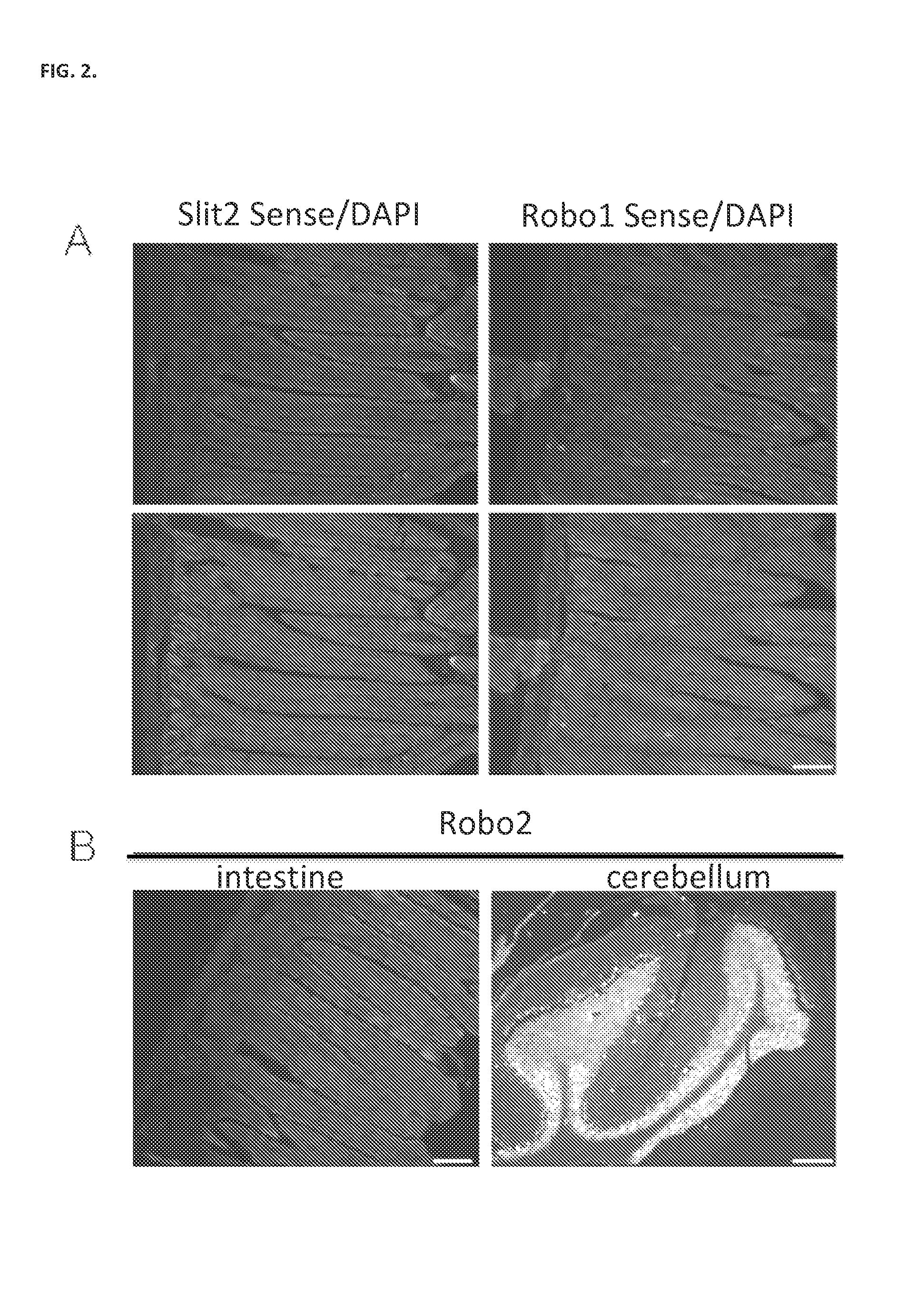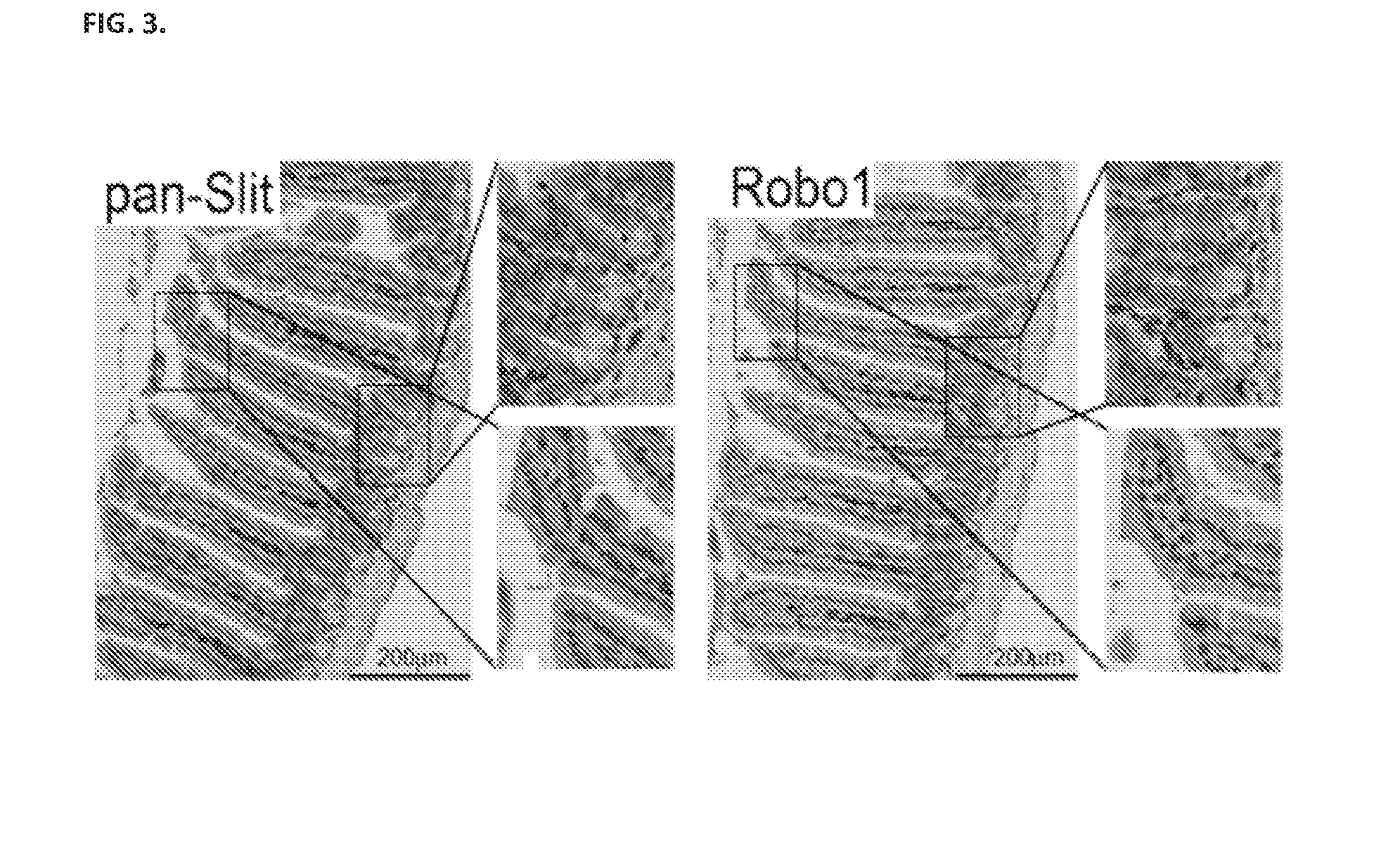Compositions and methods relating to induction of intestinal stem cell homeogenesis and/or regeneration
a stem cell homeogenesis and stem cell technology, applied in the field of compositions and methods relating to the induction of intestinal stem cell homeogenesis and/or regeneration, can solve the problems of intestinal tissue loss, devastating and sometimes lethal intestinal, intestine is particularly susceptible to chemoradiation, etc., to prolong the overall survival, reduce lethal tissue damage, and mitigate chemoradiation-induced tissue injury
- Summary
- Abstract
- Description
- Claims
- Application Information
AI Technical Summary
Benefits of technology
Problems solved by technology
Method used
Image
Examples
example 1
[0173]This example describes expression of Slit2 and Robo1 on ISCs at the crypt. Two-color fluorescent were used in situ hybridization (FISH) with antisense mRNA probes to visualize Slit2 and Robo1 mRNAs in the small intestines of C57BL / 6 (Wt) mice. Surprisingly, Slit2 and Robo1 mRNAs were co-localized and were expressed markedly higher amounts in the crypts than in the villi (FIG. 1A). For specificity control, the Slit2 and Robo1 sense mRNA probes detected only background staining (FIG. 2A). To detect Slit2 and Robo1 proteins, the 51 monoclonal antibody (mAb) were used to detect pan-Slit antigens and the R4 mAb to detect Robo1 antigen (see, e.g., Wang, B., et al. (2003) Cancer Cell 4, 19-29; Zhou, W. J., et al. (2011) Cell Res. 21, 609-626). Both proteins were found at higher concentrations in the crypts than in the villi (FIG. 3). The expression of both Slit2 and Robo1 localized at the crypt of small intestine mirrors the well-characterized gradient of active β-catenin at the cryp...
example 2
[0175]This example describes aberrant Intestinal Homeostasis in Robo1 / 2 Double Heterozygotes. Complete or partial genetic deletion of Robo1 is embryonic lethal (see, e.g., Andrews, W., et al., (2006) Development 133, 2243-2252) while mice with partial genetic deletion of both Robo1 and 2 (Robo1− / + / 2− / +) are viable (see, e.g., Grieshammer, U., et al., (2004) Dev. Cell 6, 709-717; Long, H., et al., (2004) Neuron 42, 213-223). Thus, the intestinal morphology in Robo1 / 2 double heterozygotes was examined. Compared to Wt mice, Robo1 / 2 double heterozygotes displayed reduced expression of Robo1 protein, but not Slit2 or α-tubulin (α-tub; FIG. 7A). Notably, Robo2 mRNA was absent in the Wt small intestine, even though it was clearly present in the cerebellum (FIG. 2B). Robo1 / 2 double heterozygotes were thus considered as a murine model for partial genetic deletion of Robo1 for intestinal study.
[0176]Compared to Wt littermates, Robo1 / 2 double heterozygotes had noticeably sparser, shorter and f...
example 3
[0177]This example describes how neutralization of Slit2 binding to Robo1 inhibits intestinal development. To complement the findings in the Robo1− / + / 2− / + intestine, whether neutralization of Slit2 binding to Robo1 could temporally prevent intestinal regeneration was tested. R5, a monoclonal antibody (mAb) that binds to the first immunoglobulin domain of Robo1 and neutralizes Slit2 binding to Robo1 was used (see, e.g., Wang, B., et al., (2003) Cancer Cell 4, 19-29; Mertsch, S., et al., (2009) J. Neurooncol. 87, 1-7; Wang, L. J., et al., (2008) Cancer Sci. 99, 510-517; Urbich, C., et al., (2009) Blood 113, 5669-5679; Zhang, B., et al., (2009) Blood 114, 4300-4309; Yang, X. M., et al., (2010) Biochem. Biophys. Res. Commun. 396, 571-577; Khusial, et al., (2010) Oncotarget 1(3) 198-209; Ye, B. Q., et al., (2010) J. Immunol. 185, 6294-6305; Zhou, W. J., et al., (2011) Cell Res. 21, 609-626; Guijarro-Muñoz, I., et al., (2012) Exp. Cell Res. 318, 371-378). It should be noted that R5 only r...
PUM
 Login to View More
Login to View More Abstract
Description
Claims
Application Information
 Login to View More
Login to View More - R&D
- Intellectual Property
- Life Sciences
- Materials
- Tech Scout
- Unparalleled Data Quality
- Higher Quality Content
- 60% Fewer Hallucinations
Browse by: Latest US Patents, China's latest patents, Technical Efficacy Thesaurus, Application Domain, Technology Topic, Popular Technical Reports.
© 2025 PatSnap. All rights reserved.Legal|Privacy policy|Modern Slavery Act Transparency Statement|Sitemap|About US| Contact US: help@patsnap.com



